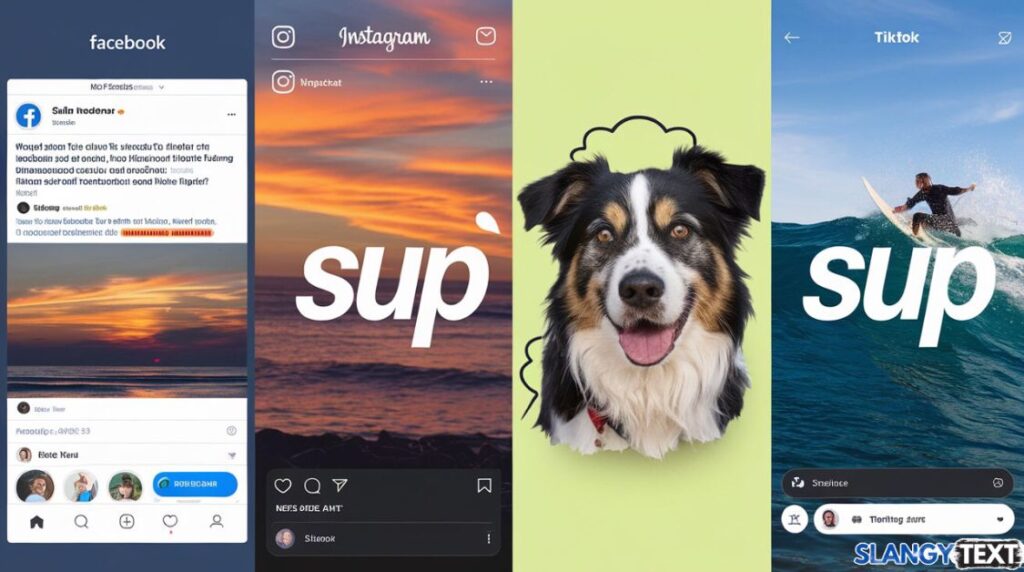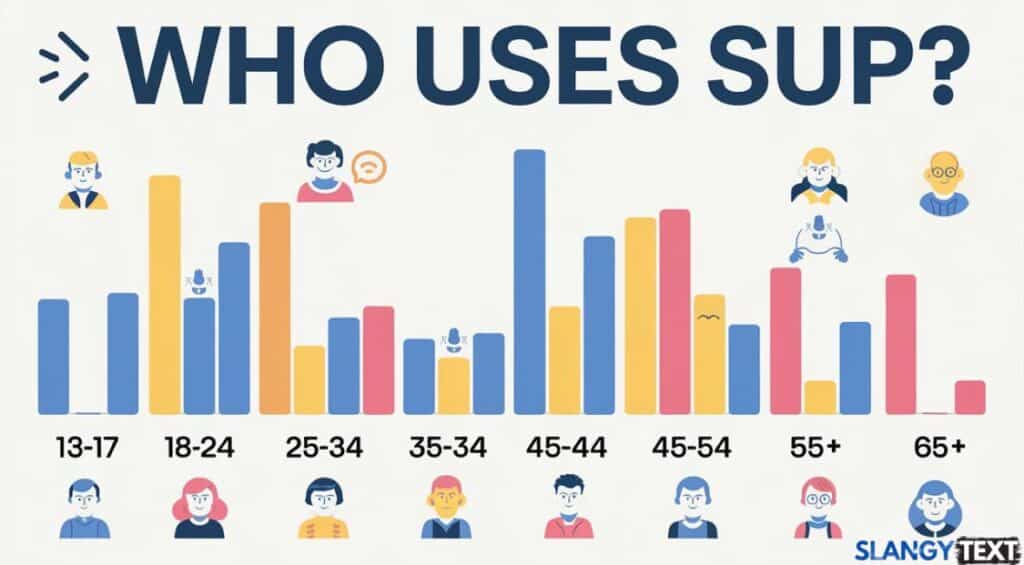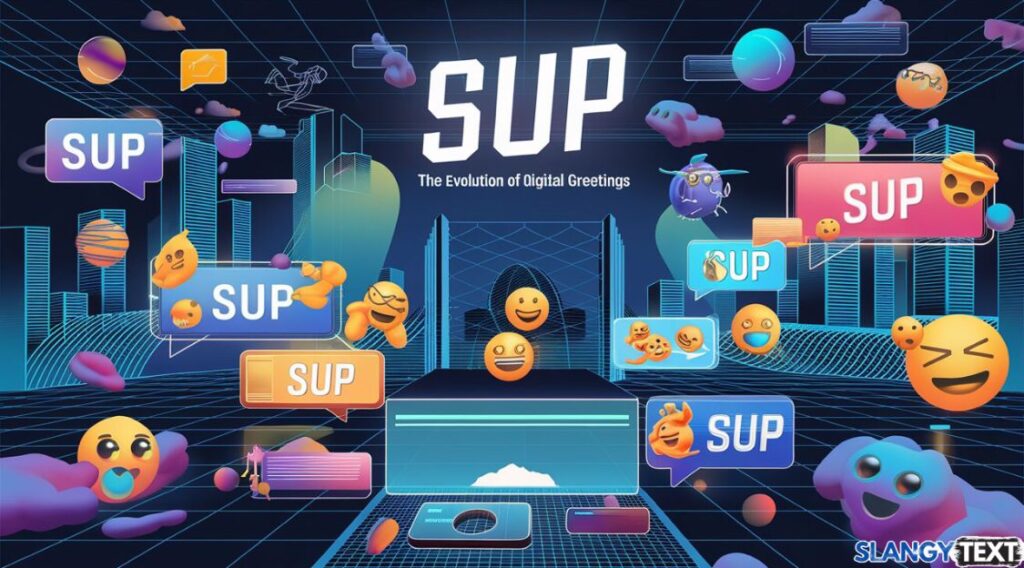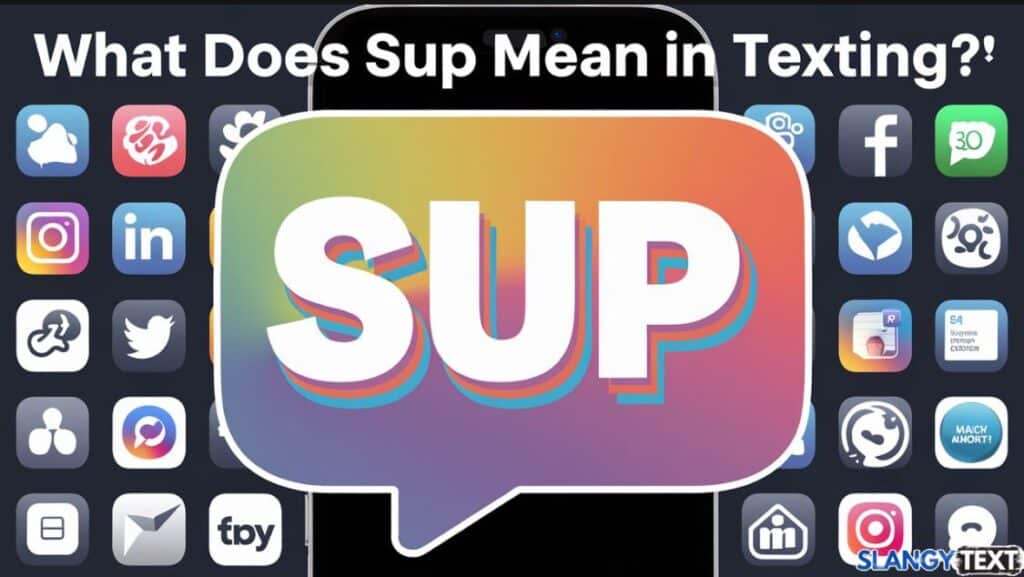In the ever-evolving landscape of digital communication, abbreviations and slang have become integral to our daily conversations. One such abbreviation that has gained widespread popularity is “SUP”.Let’s dive into the SUP meaning!
This seemingly simple term has found its way into countless text messages, social media posts, and casual online interactions. But what exactly does SUP mean, and how has it impacted our digital communication?
The Origins of SUP
The origins of SUP can be traced back to the early days of text messaging when character limits and slow typing speeds necessitated brevity. As mobile phones became more prevalent and texting gained popularity, users sought ways to communicate more efficiently. This led to the creation of numerous abbreviations and acronyms, with SUP being one of the most enduring.
Decoding SUP
SUP is an informal greeting that stands for “What’s up?” It’s a shortened version of the classic casual greeting used to inquire about someone’s current state or activities. The abbreviation emerged as a quick and efficient way to initiate conversations in the fast-paced world of texting and instant messaging.
Text Message Examples
| Sender | Recipient | Message |
|---|---|---|
| Jake | Emma | “Sup Emma! How’s your day going?” |
| Olivia | Ethan | “Sup Ethan, wanna grab coffee later?” |
| Liam | Sophia | “Sup Sophia! Did you catch the game last night?” |
| Ava | Noah | “Sup Noah, how’s the new job treating you?” |
| Mason | Isabella | “Sup Isabella! Long time no chat, what’s new?” |
| Mia | William | “Sup William, are we still on for movie night?” |
| James | Charlotte | “Sup Charlotte! How was your vacation?” |
| Amelia | Benjamin | “Sup Benjamin, can you help me with my math homework?” |
| Elijah | Harper | “Sup Harper! Want to join our study group tonight?” |
| Evelyn | Michael | “Sup Michael, did you hear about the concert next week?” |
You might also like to read this : What Does Wytb Mean in Texting (With Examples)
From Text to Social Media
As social media platforms like Facebook, Instagram, and Twitter gained traction, SUP transcended its texting roots and became a common greeting across various digital platforms. Its versatility and casual nature made it perfect for initiating conversations in different online contexts.
SUP in Various Social Media Platforms

Facebook and SUP
On Facebook, SUP is often used as a conversation starter in Messenger chats or as a casual greeting in comments. Its informal tone aligns well with the platform’s focus on connecting friends and family.
Facebook Messenger Examples
| Sender | Recipient | Message |
|---|---|---|
| Sophia | Liam | “Sup Liam! Saw your new profile pic, looking good!” |
| Noah | Emma | “Sup Emma, how’s college life treating you?” |
| Isabella | Mason | “Sup Mason! Are you coming to the party on Saturday?” |
| Oliver | Ava | “Sup Ava, did you finish that project we talked about?” |
| Charlotte | Ethan | “Sup Ethan! Long time no see, how have you been?” |
| Elijah | Mia | “Sup Mia, want to grab lunch tomorrow?” |
| Amelia | William | “Sup William! Can you send me the notes from yesterday’s class?” |
| James | Evelyn | “Sup Evelyn! How’s your new puppy doing?” |
| Harper | Benjamin | “Sup Benjamin, are you free for a quick call later?” |
| Michael | Olivia | “Sup Olivia! Did you see the latest episode of that show we like?” |
Instagram and SUP
Instagram users frequently use SUP in direct messages or as a comment on posts to engage with friends and followers. The brevity of SUP fits perfectly with Instagram’s visual-centric nature.
Instagram Direct Message Examples
| Sender | Recipient | Message |
|---|---|---|
| Emma | Jake | “Sup Jake! Your latest post is fire 🔥” |
| Ethan | Olivia | “Sup Olivia, where did you take that amazing sunset pic?” |
| Sophia | Liam | “Sup Liam! Wanna collab on a new photo series?” |
| Noah | Ava | “Sup Ava, your story made me laugh so hard 😂” |
| Isabella | Mason | “Sup Mason! Can you teach me that cool photo editing trick?” |
| William | Mia | “Sup Mia, loved your new reel! How long did it take to make?” |
| Charlotte | James | “Sup James! Your travel pics are giving me serious wanderlust” |
| Benjamin | Amelia | “Sup Amelia! Want to join our Instagram challenge this week?” |
| Harper | Elijah | “Sup Elijah! Your food pics always make me hungry 😋” |
| Michael | Evelyn | “Sup Evelyn! How do you always find the best street art spots?” |
Also like to know this : What Does Thumb In or Thumb Out Mean on TikTok?
Snapchat and SUP
Snapchat’s ephemeral content model makes SUP an ideal greeting for quick exchanges. Users often send snaps with SUP overlaid on images to initiate conversations.
Snapchat Examples
| Sender | Recipient | Message |
|---|---|---|
| Liam | Sophia | “Sup Sophia! Check out this new filter I found” |
| Emma | Noah | “Sup Noah, streaks! How’s your day going?” |
| Mason | Isabella | “Sup Isabella! Want to meet up at the park later?” |
| Ava | Oliver | “Sup Oliver, did you see my new Bitmoji?” |
| Ethan | Charlotte | “Sup Charlotte! Can you send me that homework snap again?” |
| Mia | William | “Sup William, let’s do a group snap with the squad!” |
| James | Amelia | “Sup Amelia! Your snap story is hilarious today” |
| Evelyn | Michael | “Sup Michael, want to swap faces on our next snap?” |
| Benjamin | Harper | “Sup Harper! Did you get my snap about the concert tickets?” |
| Olivia | Elijah | “Sup Elijah, let’s see who can keep the longest snap streak!” |
TikTok and SUP
While TikTok is primarily a video-sharing platform, SUP has found its way into video captions and comments as a way to grab attention or start interactions.
TikTok Comment Examples
| Commenter | Creator | Comment |
|---|---|---|
| Jake | Emma | “Sup Emma! Your dance moves are on point 👌” |
| Olivia | Ethan | “Sup Ethan, can you do a tutorial for that transition?” |
| Liam | Sophia | “Sup Sophia! Your lip-sync game is strong 💪” |
| Ava | Noah | “Sup Noah, loved your duet! Let’s collab sometime” |
| Mason | Isabella | “Sup Isabella! Your comedy skits always crack me up 😂” |
| Charlotte | William | “Sup William! How long did it take you to learn that trick?” |
| Amelia | James | “Sup James! Your travel content is giving me major FOMO” |
| Elijah | Mia | “Sup Mia, can you share the sound you used in your last video?” |
| Harper | Benjamin | “Sup Benjamin! Your transitions are so smooth, what’s your secret?” |
| Michael | Evelyn | “Sup Evelyn! Your POV videos are always so creative” |
The Emotional Context of SUP
Understanding the emotional context of SUP is crucial for effective communication. While it’s generally considered a friendly and casual greeting, the tone can vary depending on the relationship between the sender and recipient.
Friendly SUP
When used between friends, SUP often conveys a warm and welcoming tone. It’s a way of saying, “Hey, I’m thinking about you and want to chat.”
Casual SUP
In more casual acquaintances, SUP serves as a low-pressure way to initiate conversation without seeming too formal or intrusive.
Neutral SUP
Sometimes, SUP is used as a neutral greeting when the sender wants to maintain a casual tone without conveying any specific emotion.
You might also like this too: What Does WU Mean In Texting?
SUP vs. Formal Greetings
While SUP has become ubiquitous in informal digital communication, it’s important to recognize when it’s appropriate to use and when a more formal greeting is necessary.
Informal Settings
In personal conversations, social media interactions, and casual group chats, SUP is generally acceptable and often welcomed.
Formal Settings
In professional emails, business communications, or academic contexts, it’s best to avoid using SUP and opt for more formal greetings like “Hello” or “Good morning.”
Professional Email Examples (Inappropriate Use of SUP)
| Sender | Recipient | Subject | Message |
|---|---|---|---|
| Jake | Emma (Manager) | Project Update | “Sup Emma! Here’s the latest on the Johnson account.” |
| Olivia | Ethan (CEO) | Quarterly Report | “Sup Ethan, attached is the Q3 financial summary.” |
| Liam | Sophia (Client) | Meeting Request | “Sup Sophia! Can we schedule a call to discuss the proposal?” |
| Ava | Noah (HR Director) | Leave Application | “Sup Noah, I need to take next week off for a family event.” |
| Mason | Isabella (Professor) | Assignment Submission | “Sup Isabella! Here’s my term paper for review.” |
| Charlotte | William (Interviewer) | Interview Follow-up | “Sup William! Thanks for meeting with me yesterday.” |
| James | Amelia (Customer) | Order Confirmation | “Sup Amelia! Your order #12345 has been shipped.” |
| Benjamin | Harper (Colleague) | Team Building Event | “Sup Harper! Are you joining us for the company retreat?” |
| Evelyn | Michael (Supplier) | Invoice Query | “Sup Michael, there seems to be a discrepancy in the latest invoice.” |
| Elijah | Mia (Board Member) | Annual Report | “Sup Mia! Please find the annual report attached for your review.” |
Audience Appropriateness
Considering your audience is crucial when deciding whether to use SUP. Let’s explore some scenarios where SUP might or might not be appropriate.

Youth Communication
SUP is widely accepted and used among younger generations, particularly in text messages and social media interactions.
Professional Communication
In most professional settings, SUP is generally considered too casual and may be perceived as unprofessional or disrespectful.
Intergenerational Communication
When communicating with older family members or acquaintances, it’s important to consider whether they’re familiar with texting slang like SUP.
Intergenerational Text Examples
| Younger Sender | Older Recipient | Message |
|---|---|---|
| Emma | Grandpa Jake | “Sup Grandpa! How’s your garden doing?” |
| Noah | Aunt Olivia | “Sup Aunt Olivia, thanks for the birthday card!” |
| Sophia | Uncle Liam | “Sup Uncle Liam! Can you help me with my car trouble?” |
| Ethan | Grandma Ava | “Sup Grandma! Are we still on for Sunday dinner?” |
| Isabella | Great-uncle Mason | “Sup Great-uncle Mason! I found an old photo of you, want to see?” |
| William | Cousin Charlotte (40s) | “Sup Cousin Charlotte! How are the kids doing in school?” |
| Mia | Family friend James (60s) | “Sup Mr. James! Mom wanted me to invite you to our BBQ next weekend.” |
| Amelia | Older neighbor Evelyn | “Sup Mrs. Evelyn! Do you need any help with your groceries this week?” |
| Benjamin | Great-aunt Harper | “Sup Great-aunt Harper! Can you tell me more about our family history?” |
| Elijah | Older coworker Michael | “Sup Michael! Can you show me how to use the new copier?” |
Also like to know this: What Does Tsts Mean in Texting (With Examples)
SUP and Slang Usage
SUP is just one example of the many slang terms and abbreviations used in digital communication. Understanding these terms can help bridge generational gaps and improve overall communication.
Internet Lingo Evolution
The rise of SUP reflects the broader trend of internet lingo evolving to meet the needs of fast-paced digital communication.
Colloquial Expressions
SUP falls into the category of colloquial expressions that have found new life in the digital age, adapting to the unique constraints and opportunities of online platforms.
Is SUP Safe for Children
Parents often wonder about the appropriateness of texting slang like SUP for their children. Let’s examine the considerations surrounding this issue.
Family-Friendly Nature
SUP is generally considered a harmless and family-friendly greeting, free from explicit or offensive connotations.
Teaching Moment
Discussing SUP and similar abbreviations with children can be an opportunity to teach them about context-appropriate communication.
SUP in Educational Settings
The use of SUP and other texting slang in educational contexts raises interesting questions about language evolution and academic standards.
Classroom Discussions
Some educators incorporate discussions about texting language like SUP to explore linguistic trends and digital communication norms.
Writing Standards
While SUP might be discussed in a classroom setting, it’s generally not considered appropriate for formal academic writing.
Educational Context Examples
| Student | Teacher/Professor | Context | Message |
|---|---|---|---|
| Jake | Ms. Emma | Homework Question | “Sup Ms. Emma! Can you clarify the instructions for the essay?” |
| Olivia | Prof. Ethan | Office Hours | “Sup Prof. Ethan, are you available for a quick meeting tomorrow?” |
| Liam | Dr. Sophia | Research Project | “Sup Dr. Sophia! I’ve completed the first phase of the experiment.” |
| Ava | Mr. Noah | Club Activity | “Sup Mr. Noah, when is the next debate team meeting?” |
| Mason | Coach Isabella | Sports Practice | “Sup Coach Isabella! Will practice be indoors today due to rain?” |
| Charlotte | Librarian William | Book Request | “Sup Mr. William! Do we have any copies of ‘1984’ available?” |
| James | Counselor Amelia | Appointment | “Sup Ms. Amelia, can I schedule a counseling session for next week?” |
| Evelyn | TA Michael | Lab Report | “Sup Michael! I’m having trouble with the data analysis section.” |
| Benjamin | Dean Harper | Academic Advice | “Sup Dean Harper! Can I get your input on my course selection?” |
| Elijah | Prof. Mia | Research Opportunity | “Sup Prof. Mia! I’m interested in joining your research team.” |
Business Formality and SUP
In the business world, understanding when and how to use informal language like SUP can be crucial for maintaining professionalism while also building rapport.
Corporate Communication
Most corporate environments discourage the use of SUP and similar slang in official communications to maintain a professional image.
Client Relationships
When building relationships with clients, it’s essential to gauge their communication style before using casual greetings like SUP.
Real-life Examples of SUP Usage
To better understand how SUP is used in various contexts, let’s look at some real-life examples across different digital platforms.
Text Message Scenarios
Text messages often serve as quick check-ins, making SUP a popular choice for initiating conversations.
Social Media Interactions
On social platforms, SUP can be used to comment on posts, start direct message conversations, or engage with content creators.
SUP and Quick Replies
The brevity of SUP makes it ideal for quick exchanges, especially in situations where a full conversation might not be possible or necessary.
Instant Messaging
In instant messaging apps, SUP often serves as a way to check if someone is available to chat without demanding an immediate response.
Social Media Comments
Commenting “SUP” on a friend’s social media post can be a way of acknowledging their content without engaging in a lengthy conversation.
The Future of SUP
As digital communication continues to evolve, what does the future hold for abbreviations like SUP?

Emerging Platforms
New social media platforms and messaging apps may influence how and where SUP is used in the future.
Language Evolution
The staying power of SUP will depend on how language continues to adapt to technological changes and cultural shifts.
Conclusion
In conclusion, “SUP” has firmly established itself as a versatile and widely recognized greeting in digital communication. From its origins in text messaging to its widespread use across various social media platforms, SUP exemplifies how language evolves to meet the needs of fast-paced online interactions. While its casual nature makes it ideal for informal exchanges among friends and younger generations, it’s important to recognize its limitations in professional or formal settings. As digital communication continues to evolve, SUP serves as a prime example of how abbreviations and slang can become integral parts of our everyday language, bridging gaps and facilitating quick, friendly interactions in our increasingly connected world.
Also like to know this : What Does HMU Mean In Texting?

Kayla Rogers is a writer at Slangy Text who loves exploring modern acronyms & slangs and how they shapes our conversations. She enjoys sharing fun and interesting articles that connect with readers. When she’s not writing, Kayla likes to keep up with the latest trends or relax with a good book.







